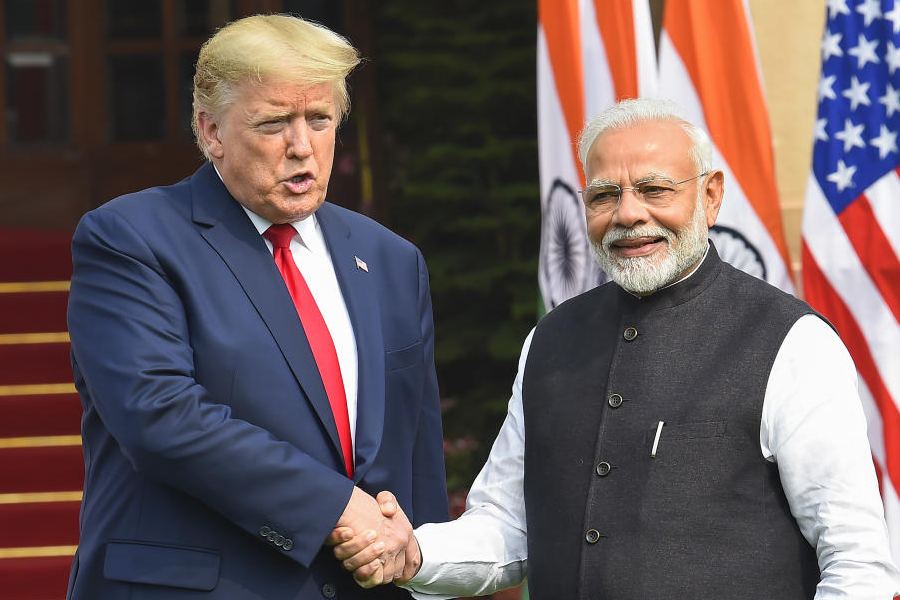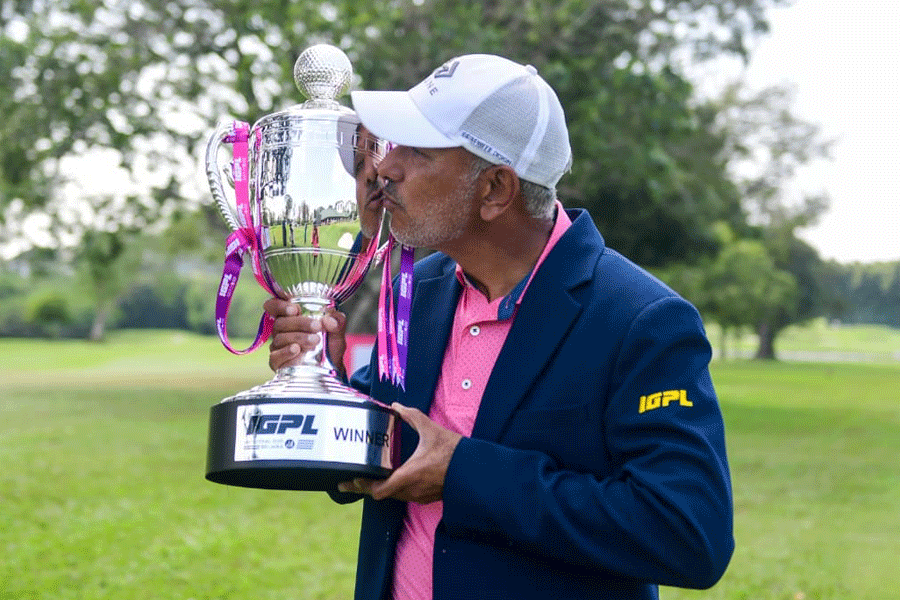 |
| Frank Kelly (fourth from left), Master of Christ’s College, Cambridge, at the unveiling of JC Bose’s bust with (left to far right) Shiv Shankar Mukherjee, the Indian high commissioner in London; Bikash Sinha, the Saha Institute director; Biman Das, sculptor; and Sibaji Raha, the Bose Institute director |
Jagadish Chandra Bose (1858-1937) was the “pioneer of electromagnetic waves”, according to a biographical note circulated by Christ’s College, Cambridge, where he was admitted in 1882 to read natural sciences.
He took his BA in 1884 and MA in 1896, College records show. The College says he is “widely regarded as the first modern Indian scientist” and describes him as “a far-sighted visionary and gifted experimentalist”.
It says: “In 1895 in Calcutta he publicly demonstrated wireless transmission of electromagnetic waves for the first time anywhere in the world, using the waves to ring a distant bell to thereby explode some gunpowder.”
It points to verification by a British newspaper of the experiment. “The Daily Chronicle of England noted in 1896 that ‘the inventor (J.C. Bose) has transmitted signals to a distance of nearly a mile and herein lies the first and obvious exceedingly valuable application of this new theoretical marvel’.”
Bose, according to the note, “was invited by Lord Rayleigh (the physicist) to present his experiments at the Royal Institution in January 1897, attended by Marconi’s business partner who importuned him to take out a patent and share his proceeds with him. Bose refused on the grounds that scientific discoveries must inure to the benefit of the public.”
It goes on: “Marconi’s wireless transmission on Salisbury Plain did not occur until May 1897. Bose also crossed from physics into biology, challenging widespread notions that these realms were different — among the fields he is regarded to have anticipated is cybernetics, through his model of memory as an information storage device.”
Further, “his boundless curiosity led him to study electrical response of plants and the phenomenon of photosynthesis. Freethinking pioneer and icon, Bose was born and educated in rural Bengal and later Calcutta and achieved a knighthood and international distinction”.
Negotiations to found the annual J.C. Bose Scholarship, at Christ’s College for two students from India to read natural sciences, are being conducted by professor Ranjit Nair, director, Centre for Philosophy and Foundations of Science in Delhi.
Nair, who was himself a student at Christ’s, revealed he was recently allocated D5 in the second court in the College during a visit.
“Later, I found out this was the room which Jagadish Chandra Bose had when he was at Christ’s,” said Nair.
WHO SAID WHAT
Ennackal Chandy George Sudarshan, physicist at the University of Texas, Austin
We are talking about electromagnetic wave propagation through space. Bose did it first; the other man (Marconi) copied it and copied it in a larger way. The scientific community now accepts this.
An injustice has been corrected. Bose must have felt it for a long time but who would he complain to? The work that Jagadish Bose did was done two years before Marconi did anything. Marconi must have been a very smart fellow because Bose gave a number of lectures, one on the continent and several in England and these were public lectures with demonstrations. They showed radio transmission (over) one mile. This was written up in The Daily Chronicle newspaper in England, saying this was a great thing. It is quite possible that Marconi attended one of those lectures.
Marconi said: ‘I will show it,’ and he did in England. But it was two years after Jagadish Chandra Bose.
Julia Davies, department of plant sciences, Cambridge:
Professor Bose was one of the pioneers of plant electrophysiology. He showed plants use an electrical messaging system. He realised that plants can sense changes in their environment and may use electrical signals to trigger their adaptation to those changes.
Today, the proteins responsible for those electrical signals are being characterised and the genes encoding them are being identified. With that understanding comes the opportunity to enhance the ability of plants to withstand adverse growth conditions.
Ray Goldstein, professor in the department of applied mathematics and theoretical physics, Cambridge:
A lot of modern research is in the spirit of what professor Bose would have liked.
Jim Haseloff, department of plant sciences, Cambridge:
His experiments were the precursor of many of the experiments done today, dealing with the physical aspect of gene expression.
Martin Rees, cosmologist and astrophysicist; Master of Trinity College, Cambridge; the Astronomer Royal; and president of the Royal Society:
I am attending the centenary conference of the Indian Institute of Science in Bangalore from December 13 to 16. I am giving one of the public lectures on the future of our understanding of the universe and space over the next 25 or 50 years.
It will be a wonderful chance to see a large collection of the leading scientists in India. It is an institute which was founded 100 years ago with some support from the Royal Society of which I am now the president.
Well, I knew little about the work of professor Bose and that is why I wanted to come to this meeting at Christ’s. It was a revelation to learn how much of a pioneer he was in different areas of science.
I am Master of Trinity College which had Nehru as a student 101 years ago and his grandson Rajiv Gandhi. Amartya Sen was my immediate predecessor as Master. The present Prime Minister, Manmohan Singh, was also at Cambridge.
We have many connections with Indian science. I am concerned we should strengthen these, especially in areas like nano-technology.










